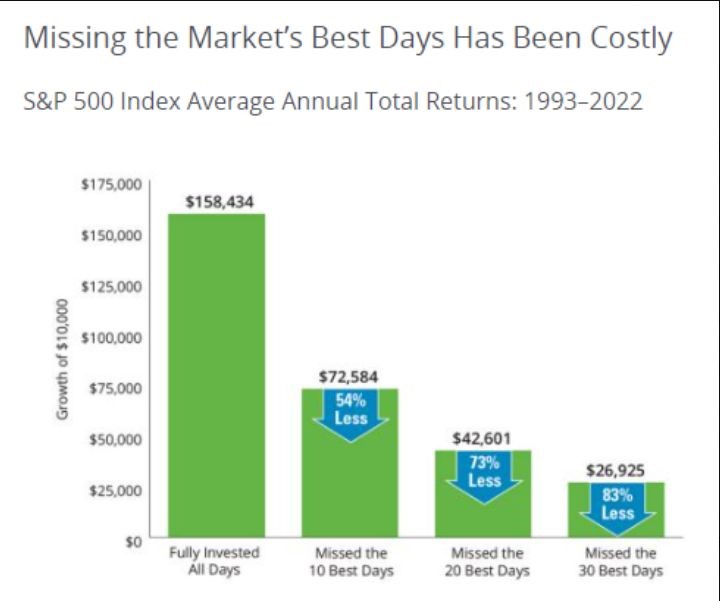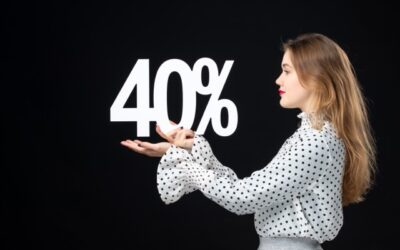Is it time to buy now?
Remember all those charts showing how the performance of your portfolio will be halved if you missed the 10 best trading days on the market? This week we saw one of those days. Is it time to buy now?
Source: rferri
The temptation to time the market
Global markets have experienced increased levels of volatility over the past 12 months, with investors grappling with inflation, central bank policies, ongoing geopolitical tensions and economic uncertainty.
Many investors were tempted to time the market, hoping to buy low and sell high to maximize their returns. However, as we will explore in this report, it is an extremely challenging strategy to try to time the market to implement correctly and consistently. This is especially true with extreme market timing tactics, such as moving a majority of their investment assets into cash to avoid a bear market or take advantage of a major market correction. Instead, remaining relatively ‘invested’ over the long term has proven to be a much more reliable strategy for achieving sustainable investment returns.
The danger of going completely cashless
Aggressively trying to time the peaks and troughs of market cycles can prove to be risky, as it is extremely difficult to predict when these major troughs and peaks will occur. Stock markets can be volatile in the short term, but in the long term they tend to rise. This means that an investor who stays in the market generally has a much higher probability of long-term success than one who tries to pick the perfect time to invest.
Historically, every market downturn has been followed by an eventual upturn. As a long-term investor, it is important not to worry about trying to get the absolute lowest point when putting money into the market. Dollar cost averaging is generally a better strategy. The anxiety that keeps investors on the sidelines may save them that pain, but it can ensure that they will miss out on profits.
After a 15% fall from the peak in April 2022 to the trough in June 2022, the ASX200 recovered by 10% at the turn of the year and has continued to move higher so far in 2023, recovering 14% so far from that trough in June 2022. This example illustrates that one of the biggest risks in trying to time markets is potentially missing the market rallies that tend to follow market declines.
The risk of missing
The last decade has been worrying for many investors. The recession of 2008-2009, also known as the financial crisis, made some investors so fearful that they stopped contributing to their accounts, or even withdrew their money at market lows, locking in losses.
The very sharp but short Covid market dislocation was another good example. Investors may have thought that sitting out for a while seemed like a good strategy, but the Covid recovery was very fast. Trying to avoid the worst cases also means missing the opportunity for gains (and often investors come out too late to avoid the worst of the downturn).
“Time in” the market generally beats “timing” the market because many of the best days occur during or immediately after downturns. Looking at the last 30 years, the top 10 trading days occurred during recessions and five of them took place during a bear market. As a recent example, three of the best days for stocks in the last 30 years occurred in March and April 2020.
Being invested (and staying relatively invested) in the market is the key to long-term investment success. While it may be tempting to try to avoid the worst days in the market, it is almost impossible to both avoid the worst days and catch the best days.
If an investor had invested in the market for a full 10-year period to date, the annual return the investor would have generated is 8.6%. This is an outstanding annual return, especially given that the period includes the near-bear market of 2018, the Covid recession of 2020, and the 40-year high inflation and bear market of 2022.
By missing only the 10 best trading days over those 10 years, an investor’s annual return was halved – a significant impact when you consider that it is equivalent to missing on average just one day in the market every 12 months.
In the worst case, if an investor missed the market and missed the best 50 trading days, the annual return over the same period would have been -5.2%. This illustrates that the opportunity cost of being outside the market can be high. Since the highest gains often occur during or just after a correction, missing these gains can drastically reduce an investor’s average return over time.
Of course, investors can also exit the market and miss the worst days. However, studies show that people generally stop investing when the market is down, after a particularly severe downturn, and they come back after the market has already started to bounce back.
Keeping a long-term focus
Taking a long-term investment perspective is important – especially for growth-oriented investment strategies. It is easy to get caught up in short-term volatility, especially when markets are either falling or going through bouts of volatility.
Investing in growth assets requires investors to adopt a long-term investment time horizon and accept that the value of their portfolio will fluctuate significantly over short periods of time.
History has shown that positive outcomes occur much more often over longer periods than shorter ones. One-year investments were more likely to produce negative results than investments held for longer periods. If these short-term, one-year investors had lasted just two or more years, they would have experienced almost half as many negative periods.
And the longer the timeframe, through peaks and troughs, the greater the chances of a positive outcome. In fact, over the last 60 years, 90% of the 10-year periods have been positive. Investors who have stayed in the market during occasional (and inevitable) periods of declining stock prices historically have been rewarded for their long-term outlook.
Time is your best friend
Rather than aggressively trying to time peaks and troughs, it is important to continue investing throughout market cycles. Focus on the time you remain invested, rather than the timing of your investments.
Being invested (and staying invested) in the market is the key to long-term investment success. The temptation to ‘time’ the market and deviate significantly from your strategic asset allocation during volatile markets is strong, but the opportunity cost can be high. It is extremely difficult to predict the start of the next downturn or what markets will do in the short term.
A growth-oriented investor’s real advantage lies in the understanding of long-term capital market returns and the power of amplifying returns versus hiding their money under the mattress or in a bank account.
It is also worth mentioning that volatile times are when active management and thoughtful (diversified) portfolio construction can help by adjusting exposures to better cope with the shocks. We recommend using a balanced and incremental approach to implementation. A smooth progressive entry into markets is likely to provide even more
positive results.
About the Viking
With Viking’s signals, you have a good chance of finding the winners and selling in time. There are many securities. With Viking’s autopilots or tables, you can sort out the most interesting ETFs, stocks, options, warrants, funds, and so on.
Click here to see what Vikingen offers: Detailed comparison – Stock market program for those who want to become even richer (vikingen.se)














